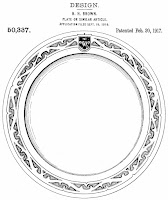After the conclusion of the Rice's First Patents Saga, it occurred to me that I may have made a mistake back in May when investigating other universities' patents. During the initial search for Rice's first patents, my search strategy inadvertently excluded anything prior to 1970. Unfortunately, the blog post about 12 other schools' first patents relied on the same strategy--I have potentially wronged these institutions.
Therefore, let's take a second look at when these Rice-caliber schools first earned U.S. patents.
This time around, University of Chicago is the clear leader, assigned its first patent in 1917... if design patents count. US D50337 is for the appearance of a plate (like the kind used for dinner; below).
Narrowed to utility patents, the first school assigned a patent is Cornell University in 1931, with US 1,810,682 (another dairy-related invention).
In 1933, Dartmouth and Stanford were both assigned their first patents, US 1,908,296 and US 1,933,773, respectively.
Next up is MIT, who was assigned patent 2,006,558 in 1935.
University of Chicago makes a reappearance in 1936 with its first utility patent, US 2,032,829.
While Rice Institute was pursuing its first three patents, there was a lull from the remaining seven. Duke University was assigned its first patent, US 2,446,091, in the same year as Rice--1948.
Almost 20 years later in 1965, Georgetown was assigned US 3,223,083. This patent is for a "Method for adhesively securing together skin and other soft tissue and bone", somewhat similar in goal to patents recently issued to Rice (US 11,447,744/11,371,014, "Hypothermic 3D bioprinting of living tissues supported by perfusable vasculature" and US 11,246,962, "Neuronal scaffold-water soluble graphene for treatment of severed spinal cords and neuronal repair").
 |
| US 3,223,083: Method for adhesively securing together skin and other soft tissue and bone |
Rather shockingly, the last five include those most highly regarded US colleges and universities, four founded before America was an independent country. The previously listed dates for Vanderbilt (1975), Princeton (1976), Harvard (1977), Yale (1977), and Brown (1984) were correct. Given the corrected information on when other institutes were pursuing patent ownership, it is even more shocking that Harvard, Yale, Princeton, and Brown didn't pursue IP ownership till the 70s and 80s, centuries after they were founded.
That is not to say American universities and colleges weren't supporting
researchers, and thus employees weren't inventing. For example, Stanford appears to have hosted a large number of patentees throughout
the late 1800s and early 1900s, before 1933.
It is possible that earlier patents were missed again, or these inventions were assigned to a college or university but were not researched at and/or supported by them; the actual patents do not provide that information.


No comments:
Post a Comment